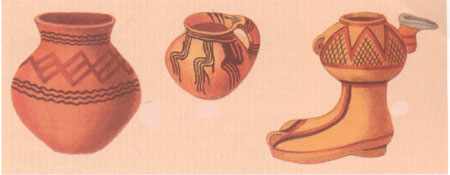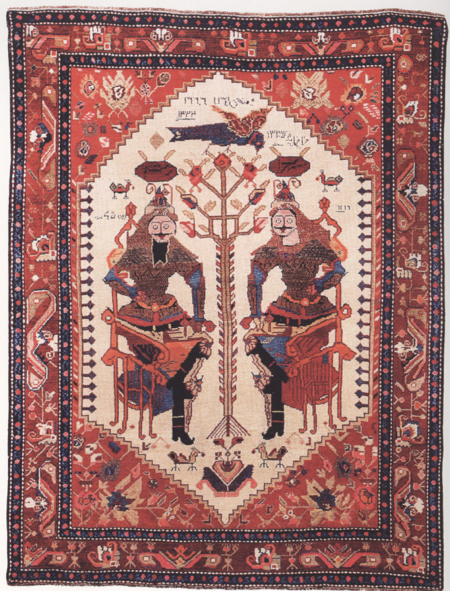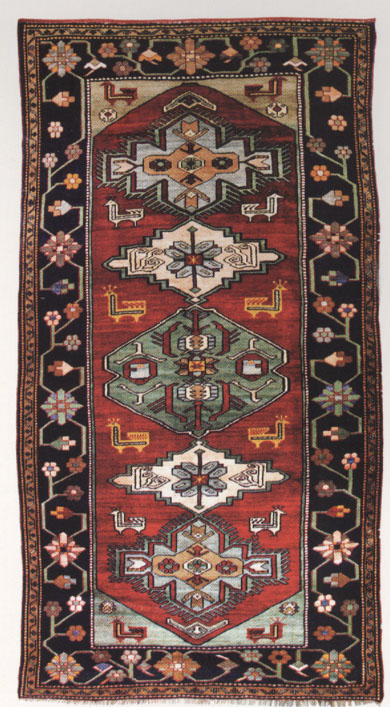Handicraft
Pottery, metal processing, brazing, stone processing, wood processing, wearing, jeweler’s art and etc., being the ancient fields of popular art, are known since Eneolit and Initial Bronze Ages. Intensive development of tillage and cattle breeding in Nakhchivan created possibilities for evolution of handicraft. The growth of cultural necessity was completed with making of jewelry, artistic design of labor tools, mode of life equipment, definite parts of arms. As the result of archaeological excavations from the ancient dwelling places (I and II Kultapa, Sadarak, Nakhta, Ovchular’s Hill, Dasharkh, Gizilburun, Shahtakhti, Garabaglar, Kulus, Kolani, etc.) brought to light different labor tools and rich handicraft examples, ornament and mode of life things. Social life manner, religious-ideological outlook, belief and traditions of ancient tribes once living on the left bank of the Araz River found their reflection in handicraft of that period. Colored clay crockery (during this period the culture of colored crockery developed in Nakhchivan differing from others with a lot of features), multi-colored decorations, also elegant jewelry goods being made from bronze and silver, golden decoration things, beads being made from different minerals, tender handicraft works being made from metal, wood, bone, clay and stone, small clay and stone statues being typical for the culture of Bronze Age, are the brightest proves to it. Pottery, being an important field of ancient handicraft, was created in the area of Nakhchivan in the IV millennium BC. Archaeological materials show that clay crockery belonging to Eneolit and Bronze Ages were prepared in a potter’s wheel and burned in special forges. The most ancient remainders of potter's forges were found in the living dweller of I Kultapa. From II Kultapa living dweller were found different-shaped colored kitchen utensils with simple, geometrical and botanic  patterns, bird and animal pictures (big pitcher, jug, bowl, pail, vase, lamp etc.), being prepared by hand, partly in potter's wheel. Decorating, coloring, squeezing, etc. of pottery goods, distinguished with their quality, motley and high quality forms are important fields of the people’s art.
patterns, bird and animal pictures (big pitcher, jug, bowl, pail, vase, lamp etc.), being prepared by hand, partly in potter's wheel. Decorating, coloring, squeezing, etc. of pottery goods, distinguished with their quality, motley and high quality forms are important fields of the people’s art.
Nakhchivan is one of the first ancient metal-processing (copper) hearths of the world. From the most ancient cultural layers of I Kultapa dwelling place different tools and adornment examples with copper-arsenic, nickel-arsenic mixtures were found. Moreover, from Plovdag necropolis of Ordubad district a lot of bronze pins and from Kultapa four pins with buttonholed heads related to Bronze Age, a piece of a knife, etc. were found. Materials, being discovered as the result of archaeological excavations, indicate that the ancient inhabitants of Nakhchivan had mastery of making labor tools and adornments from bones and stones.
Spindle heads made from stone, bone and clay, referring to trade of weaving, also very tender remainders of materials were met there. In the Middle Ages handicrafts as brazing, jeweler’s art, silkworm breeding, carpet making especially got a scope, different mode of life  equipment and jeweler goods, being prepared with high mastery and taste, gained popularity. Those handicraft goods were exported to foreign markets, too. The master of art metal Osman ibn Salman Nakhchivani’s bronze can, decorated with carving patterns (1190), is being preserved in Louvr Museum (France).
equipment and jeweler goods, being prepared with high mastery and taste, gained popularity. Those handicraft goods were exported to foreign markets, too. The master of art metal Osman ibn Salman Nakhchivani’s bronze can, decorated with carving patterns (1190), is being preserved in Louvr Museum (France).
Since the Middle Ages the technology of production was perfected, wheeled sweep coming into motion by legs (cocoon-opening loom) was used in silk production, agile weaving looms – in silk workshops. Ordubad was one of the main centers producing silk materials. Azerbaijan silk was exported to Iraq, Little Asia, Syria and different countries of Europe. Coarse calico production handicraft was widely spread in Julfa, Ordubad and Nakhchivan.In the Middle Ages carpet-making art was also developed, occupying an important place in life and economy of Nakhchivan population. Carpet-making traditions are carried on today as well.
In Nakhchivan, the abundance of green meadows, springs, and rivers have created ideal conditions for sheep breeding here for thousands of years. Sheep play an important role in the lives of local population; fine sheep’s wool, opened up opportunities for the creation and development of one of the popular arts - carpet weaving.
As in other districts of Azerbaijan, Nakhchivan carpets are divided into two large groups distinguished by their artistic characteristics: ornamental and plotted carpets. The majority of carpets produced are ornamental.
Household items like zili and shedde style horse and camel covers (chul), holdalls (mefresh), saddle-bags (khurjun), heybe and saltshakers were produced in larger numbers, mostly in mountainous regions.
Flat-woven kilims woven in Nakhchivan were very essential in daily lives. Although similar to Karabakh kilims in terms of their colors and artistic features, Nakhchivan kilims have their own unique characteristics.
Nakhchivan Zilis, woven using complicated winding techniques, are superior in quality to shedde and verni.
 Felting has been one of the historically-developed art fields in the villages of Shahbuz and Sherur. The felt, which has the ability to create coolness in summer and protect from the cold in winter, has been widely used for covering the roofs and sides of huts and shacks, covering the floors and decorating houses, making felt cloak (yapinji), hat, winding (dolaq), boots, socks, cassock (eba), gapilig (something for door), heybe, horse cover (chul), chuval (sack), sweat cloth (terlik) for cargo animals, palan (pack saddle), saddle cover, load felt, and other household needs.
Felting has been one of the historically-developed art fields in the villages of Shahbuz and Sherur. The felt, which has the ability to create coolness in summer and protect from the cold in winter, has been widely used for covering the roofs and sides of huts and shacks, covering the floors and decorating houses, making felt cloak (yapinji), hat, winding (dolaq), boots, socks, cassock (eba), gapilig (something for door), heybe, horse cover (chul), chuval (sack), sweat cloth (terlik) for cargo animals, palan (pack saddle), saddle cover, load felt, and other household needs.
Pile-weave carpets were woven more than flat-weave carpets in Nakhchivan. These carpets were also more prominent during the first developmental period of carpet-weaving art. The compositions of these carpets are made out of multi-shaped pattern elements. The decorative elements depicted on these carpets are found on faience dishes, stone and metal tools along with a variety of decorative items from different periods found during archeological excavations.
The depiction of cherkhi-felek element (four-element) that is widespread in the artistic design of Nakhchivan carpets is also encountered on cultural monuments of the II-I millennia BC. The cherkhi-felek is usually represented in the center of big medallions. This element is also found on the Nakhchivan carpets with “Chelebi” composition. Nakhchivan carpets are very different from the carpets of other districts in relation to their colors. The contrast of light and dark colors gives special harmony to the Nakhchivan carpets.
Dye-houses have operated in Nakhchivan for thousands of years. Carpet masters obtained colors from different plants, flowers, tree barks to dye the yarns. For instance, yellow and yellowish colors were obtained from sarichop, sarigul (yellow flower) and fig leaves; red and pink colors from dye plant (marena), cochineal; pea and creamy colors from onion and apple skins, oak color from nut skin; navy blue and blue colors from natural indigo imported from abroad. In order to improve the ability of natural colors, professional dyers mixed them with hardening substances like alum, salt and animal urine.
The carpets and carpet products of Nakhchivan in their original pattern composition are held in the museums and private collections in Azerbaijan and many countries of the world. The numbers of pile-weave and flat-weave carpets and other carpet products held in private collections are as follow: 5 from Nakhchivan city, 5 from Babek region, 5 from Julfa, 3 from Kengerli, 6 from Ordubad, 4 from Sederek, 6 from Shahbuz, 10 from Sherur. As a result of our studies, we obtained information about 254 weavers from 68 villages of seven regions of the AR. These include 31 from Shahbuz, 58 from Serur, 8 from Sederek , 49 from Babek, 37 from Julfa, 35 from Kengerli, and 36 from Ordubad.
At present carpet workshops operate in in the regions and villages of Nakhchivan . Educational centers aimed at developing carpet weaving have also been established. The Nakhchivan State Carpet museum has a new building where visitors can view magnificent exhibits. A number of antique pileweave and flatweave carpet products from Nakhchivan group are also displayed here.
